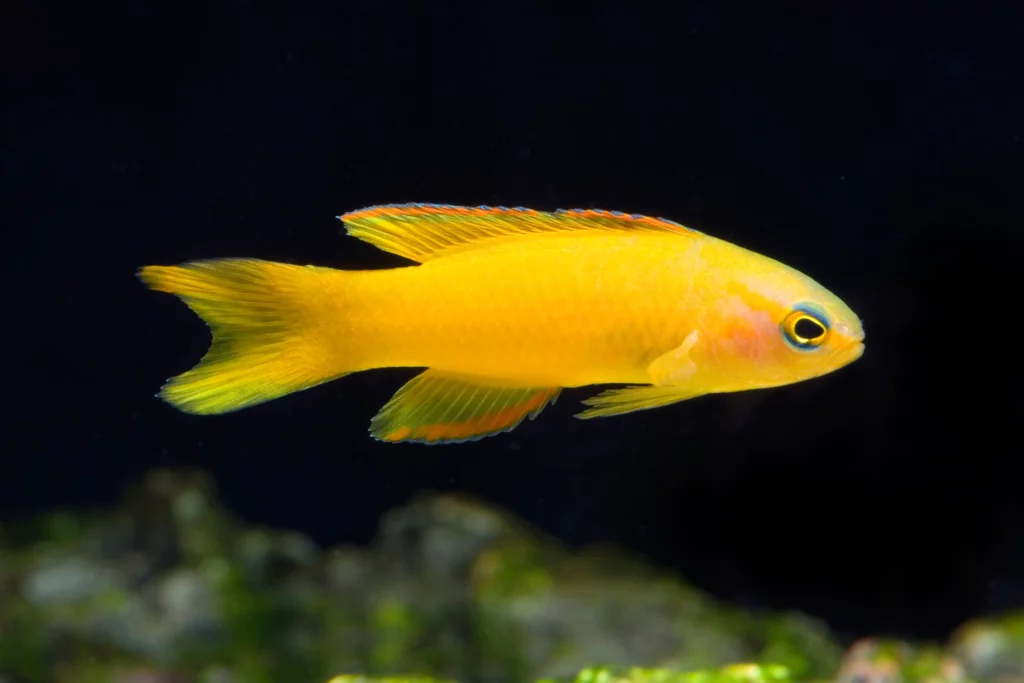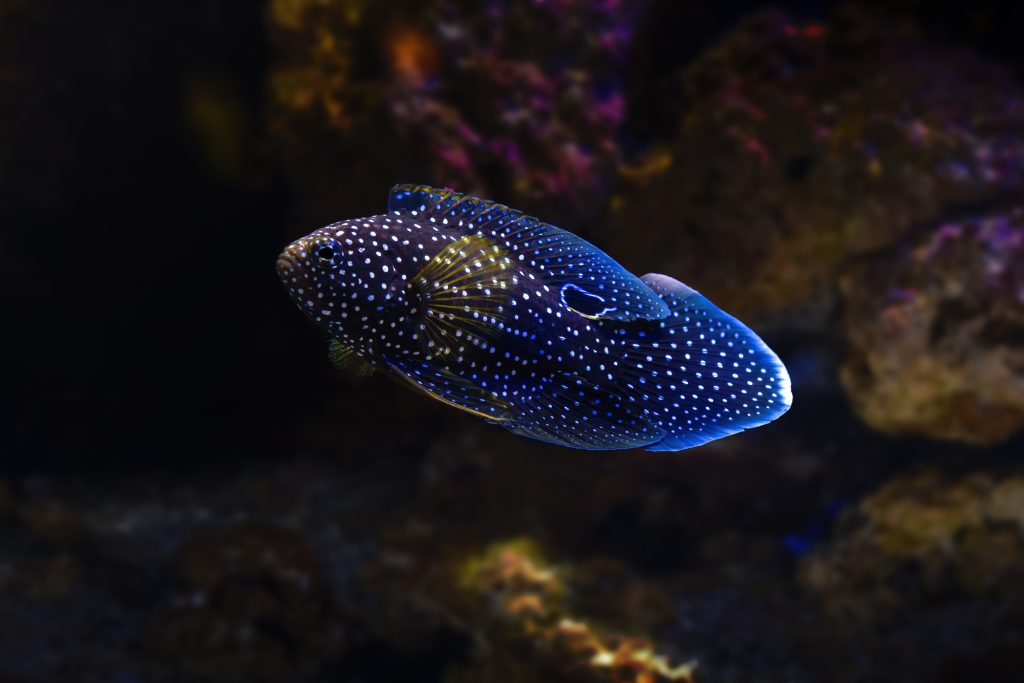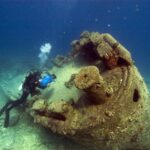Assessors and Comets
Yellow assessors and comets (marine betta) present a delightful contrast when paired in an aquarium. The vibrant yellow of the assessors adds a bright, cheerful accent. In stark and stunning contrast, the comets are like a floating work of art, adorned with a galaxy of white spots that shimmer against their dark, mysterious bodies. Together, these fish create a visually captivating display.
Assessors and marine bettas (aka comets) are the most common species within the Plesiopidae family that are kept in captivity, due to being hardy, non-aggressive, and aesthetically pleasing. These fish are often seen in reef aquariums and, when properly cared for, can help aquariums become a thriving ecosystem for many years.


Understanding Assessors and Comets, Species Overview:
There are three assessor species and one comet species:
Common Name(s): Yellow Assessor (Assessor flavissimus), Blue Assessor (Assessor macneilli), Assessor randalli (Assessor randalli), Comet (Calloplesiops altivelis).
All belong to the family Plesiopidae, otherwise known as “roundheads” or “longfins”.
Note that assessors are also commonly referred to as scissortail fishes, or devilfishes.
Although this family has seven genera, the best choices for your aquarium (and the most commonly available) come from the Assessor and Calloplesiops genera. All of the species in these groups have a good reputation for being hardy and disease-resistant.
They are usually shy at first because they like dim light, so it is important to provide plenty of rocks and ledges for them to hide under.
Although breeding in your home aquarium is possible, it is hard to rear the young of these species. However, captive-bred specimens are available and, as always, they make the better choice.
Natural Habitat and Distribution
Yellow Assessor: Native to the Indo-West Pacific Ocean region, including the Great Barrier Reef and Papua New Guinea. They inhabit caves within shallow reefs at depths between 15 and 65 feet (5 to 20 m).
Blue Assessor: Native to the western Pacific Ocean and the coral sea, where they inhabit reefs up to 65 feet (20 m) deep.
Assessor Randalli: Native to the indo-pacific ocean, where they inhabit lagoons and outer reef slopes
Comet: Native to the indo-pacific ocean, where they inhabit coral reef habitats up to 98 feet (30 m) deep
Sourcing Assessors and Comets
With global and ocean warming worsening each year, an increasing number of tropical fish are under threat of becoming endangered. To reduce their impact on wild populations, fishkeepers should obtain and manage their fish sustainably by purchasing captive-bred individuals from certified sustainable aquaria suppliers. Some well-established suppliers include:
The Biota Group
Aquarium Specialty
Algae Barn
Saltwaterfish
All these suppliers provide aquacultured fish, which are bred and raised in controlled settings that make them perfectly suitable for fishkeeping and allow easy acclimation to aquariums. These fish are also very resilient to diseases, making them perfect for hobbyists while helping preserve natural ecosystems.
Yellow Assessor for Sale
Assessors (especially yellow assessors) and comets are often listed on supplier websites such as those mentioned above. If they’re not in stock, don’t hesitate to contact the suppliers. While it may be tempting to visit major pet stores, we do not recommend purchasing saltwater fish that have not been sustainably sourced. The risk of these fish failing to acclimatize is higher, leading to increased mortality rates after purchase.
The websites we researched also contain many resources on managing and caring for your fish, so you can purchase the relevant food, tank, decor, and any other materials you’ll need along with your fish together to be delivered.
Comets or Marine bettas for sale – What you should know
Are marine bettas hard to keep?
Marine Bettas or Comets are captivatingly beautiful, but they come with a warning: they demand considerable attention to thrive in captivity. They often present challenges in feeding, preferring only live food and consuming it slowly. This behavior makes it difficult for them to compete with faster-feeding fish in the same tank.
Is a Marine Betta reef safe?
While not typically favored for reef aquariums, Marine Bettas are generally considered safe around corals and anemones. However, they tend to prey on smaller fish and shrimp. Being nocturnal, they require ample hiding spots to escape bright light and are most active during twilight.
Are marine bettas aggressive?
Marine Bettas are generally peaceful, though they do have a tendency to consume smaller fish and shrimp. Their behavior is somewhat similar to that of hawkfish, lionfish, and wrasses in this respect.
How big do marine bettas get?
Marine Bettas, also known as comets, can reach a size of up to 8 inches. They are found in the Indo-West Pacific region, inhabiting reef crevices and caves at depths ranging from 3 to 50 meters.
Pricing and Selection of Assessors and Comets
As seen earlier, there are various aquaria suppliers that sustainably culture fish to protect natural ecosystems. Here are two tables comparing the different suppliers that sell yellow assessors and comets, prices range from $60 to $209, the lowest price being at the top.
Yellow Assessors
| Supplier | Type, Size | |
|---|---|---|
| Algae Barn | Yellow Assessor, 1.25 to 1.5 inches | VIEW LATEST PRICE |
| Aquarium Speciality | Yellow Assessor, 2.5 inches | VIEW LATEST PRICE |
| Saltwaterfish | Yellow Assessor, 1.25 to 2.25 inches | VIEW LATEST PRICE |
| LiveAquaria | Yellow Assessor, 0.75 to 2.25 inches | VIEW LATEST PRICE |
Comets
Prices range from $180 to $380, the lowest price being at the top.
| Supplier | Type, Size | |
|---|---|---|
| Saltwaterfish | Comet, 1.25 to 1.75 inches | VIEW LATEST PRICE |
| Blue Zoo Aquatics | Comet, 2 to 2.5 inches | VIEW LATEST PRICE |
| LiveAquaria | Comet, 1 to 2 inches | VIEW LATEST PRICE |
| The Biota Group | Comet, 2 inches | VIEW LATEST PRICE |
Introduction, Feeding, and Health
Choosing the Right Tank
When introducing assessors and comets to your aquarium, it’s first important to pick out the right tank since the two fish species are quite different in size.
The minimum tank size for the assessors is about 20 gallons (though 30 gallons is recommended) due to their smaller size but you must have at least 55 gallons for a comet. You might also need a larger tank if you’re planning to have more than one assessor since they are known to be occasionally hostile to each other.
The tank must have numerous crevices which are very dark or devoid of light. A cave or an overhang is highly recommended. Brightly lit tanks are not the best option, but as long as dark corners exist your comet will be fine.
Assessors do well kept as a single individual or in larger tanks as pairs. Two males will fight, however, and therefore it is not recommended.
Dietary Needs
All these fish accept meaty foods such as finely chopped fresh or frozen marine fish flesh, shrimp and/or squid, mysid shrimp, vitamin-enriched brine shrimp, and frozen preparations for carnivores.
You should feed your comet around two to four times a week and your assessors about two times daily. However, if your tank is healthy and well-established, assessors need not be fed quite so often.
Maintaining The Health of Yellow Assessors and Comets
For assessors, it’s important to keep them well fed and safe from harm especially when they’re first introduced since they’re quite a timid species. This sometimes means small foods such as live baby brine, and for shelter, make sure to have ledges/shelves for them to hide or hang under.
For comets, it’s best to allow them to follow their natural hunting instincts when it comes to hunting, meaning they shouldn’t be placed with aggressive eaters. They should be given time to chase their food, and if so, they could potentially develop an interest in frozen diets. As they’re pacifists, comets also thrive when given dark cave-like hiding places. This, along with a lack of aggressive tankmates, gives comets a sense of security.
FAQ Corner
Is the yellow assessor reef safe?
The yellow assessor is reef-safe as they grow to quite a small adult size and are not hostile to other tankmates or invertebrates (except occasionally for fellow assessors).
How big do assessors and comets get?
Assessors range from 2.3 – 2.4 inches (6cm) and the Comet averages at about 8.0 inches (20cm).
What is the temperament of the yellow assessor?
Yellow assessors can be quite shy during the first few weeks to months in their new tank. Given enough time, however, they can become quite bold, even appearing out in the open during the day.
Conclusion
Whether you decide on the yellow assessor or the comet for your tank, they’re bound to make your aquarium much more vibrant. And as long as you purchase them from sustainable aquaria suppliers, you can rest easy knowing you’re taking care of both the fish in your home and the wild.
Additional Information on Compatibility
Comets may eat ornamental fish and small fishes but they are generally reclusive fish that only come out at night. Large, fast-swimming fish should be avoided if you wish to see the Comet during daylight hours. This would include but is not limited to, surgeonfish, large angels, butterflies, and some wrasses.
Being that these fish are peaceful, it is recommended that your tank be generally peaceful so the Assessors and Comets are not vulnerable to constant aggression.




